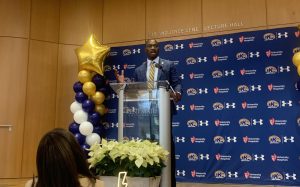Three hours in the life of ice arena staff
February 23, 2009
Reporter goes behind scenes
VIEW photos of the crew.
Seasoned members of Kent State’s Ice Arena staff have a lot to say about the student maintenance crew. Joel Gabriel, full-time recreational facility worker, calls the student crew an interesting, tight-knit, renegade group.
One of them is David Wilson, senior visual communication design major, who has worked at the Ice Arena for six years.
Last week, I tagged along with Wilson and two other maintenance staff, Steven Beavers, junior criminal justice major, and Stephen Byrne, freshman health education major, for a typical night of story-telling, pranks and a little bit of work.
It’s time to cut the ice.
Full-time employee Keith Fisher drives the Zamboni. Wilson and Byrne, or “Steve-O,” are the runners. As Fisher turns the corner, Wilson and Byrne run out onto the ice and push the hockey nets from the center of the ice to the wet, newly-smoothed corners.
“We have different jobs. When you first get in, pretty much your only job is to move the nets out of the way for the Zamboni and put it on the clean ice,” Wilson says. “As you progress up the ladder in the maintenance area, you start sharpening skates (and) driving the Zamboni.”
Steve-O has only worked about six months. He says he is usually tasked with sharpening skates.
“Everybody gets nicknames here,” Wilson says. “I think I’m the only one who doesn’t have one. I think I got in before the nickname giving.”
Next, I asked Wilson to give me a tour.
The first stop is the storage garage, a large, all-concrete room which houses the Zamboni.
“It isn’t really a Zamboni,” Wilson tells me. “It’s a UKKO.”
The UKKO (pronounced YOU-ko) is an ice resurfacing machine, similar to the Zamboni, which runs on electricity instead of gas.
For familiar purposes, we agree to call it a Zamboni.
The staff spends a lot of time in here, Wilson explains, pointing out familiar landmarks. The skate sharpener. The water pipe leading to the Zamboni. Then he turns to an empty spot on the wall.
“We used to have a basketball court back here,” he says. “We drilled a milk crate (to the wall), and we called (ourselves) the DBA – the Dirty Basketball Association.”
The DBA was a league of staff that held games in the garage during down time, until it was shut down. He isn’t sure why.
“I want to say management put it to rest,” he says.
Wilson shrugs. Then his eyes go back to the pipe.
“The line carries water to that thing,” he says, pointing to the Zamboni.
“But if you don’t unhook all the levers, then (the water) gets stuck. A few of us forgot to turn the levers and the line broke up here,” Wilson says. “We walked away to do other work, and it just started pouring down. Textbooks were back here, all in pieces.”
The maintenance staff used to be allowed to do homework at work. But they can’t do that anymore, either.
Now, with no time for school work, the staff stays busy playing pranks on each other.
“We take cups and poke holes in the bottom,” he says. “They’ll hit the coffee machine, and it will drain. When they come back, the cup will be empty.”
Next, we move out into the lobby. Beavers finally arrives, late to work by almost two hours. Wilson and Byrne give him a hard time, then laugh it off. They explain most of the maintenance staff come into the job through friends or family.
“My buddy Chris works here,” Byrne says. “I’ve known him since we were little kids.”
The maintenance staff acts like a tight-knit family, joking about the TV show they are in the middle of filming and reminiscing about the trip nine of them took to North Carolina this summer.
The pit stop is over. It’s time to cut the ice again.
This time, Beavers was behind the wheel.
He is careful not to leave any white spots. He knows his friends are watching. Wilson runs out with a shovel to scrape up the ice shavings as Beavers drives past. He tells me to throw a snowball at him. Then they take the snow outside to the “dump pile.”
“We always try to hook up the skiers and the snowboarders outside,” Wilson says. “They come and take out snow and build ramps over by the dump pit.”
“Frat guys come and take our snow for keggers, too,” Steve-O adds.
After the ice is cut, the tour continues to the locker room. We pass a youth hockey team practicing on the other side of the arena. Usually, that rink is used for broomball, Wilson explains.
“My favorite night to work is broomball night,” Wilson says.
He feels no rush because he knows he will be working late.
“We just hang out, order food – (Europe) Gyro – and watch broomball.”
Two of the teams in the broomball league this semester are made up of Ice Arena staff.
We reach the locker room, which is empty and clean. Sometimes, the scene is different, Wilson says.
“There is usually blood stains to clean up,” he says. “One night, one of the hockey players got his head stepped on by a goalie. He had to get at least 15 stitches. He started skating away, blood pouring all over the ice.”
Wilson remembers chipping the blood off the ice that night after the game was delayed.
Because of safety concerns, “You can’t have blood on the ice,” he explains.
Finally, we head up the bleachers to the balcony, where fans are watching two hockey teams play.
“We’ve had to break up fights between fans before,” Wilson says, as we pass two men screaming at the players.
Wilson watches hockey games a lot on his down time, especially the Kent State club team.
He tells me about an open senior league he also enjoys watching, with men from 18 years old to about 60, he guesses.
“It’s for anyone who’s out of high school who wants to play hockey,” he says. Beavers plays.
Suddenly the whistle blows. Fans rise to their feet screaming, as a player is thrown through the doors.
“That was cool,” Steve-O says.
“I’ve yet to see someone get checked over the boards, though,” Wilson says. “It’s been a career goal here, and I’ve never seen it. I’d pay to see it.”
Contact building and grounds reporter Samantha Laros at [email protected].












